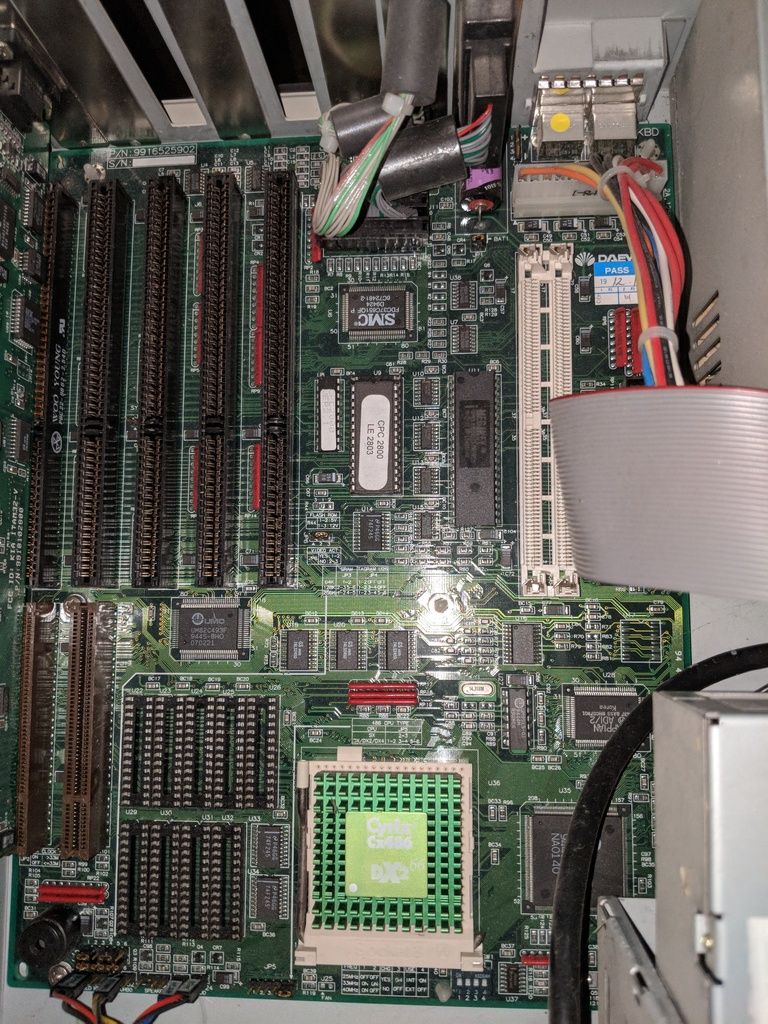First post, by PrimarchBentley
I've had this hardware kicking around for a while, but have finally gotten around to working on it (ie. I need a freakin' hobby).
The main donor is a Leading Edge Fortiva 5000 - aka. Daewoo CPC-2800. Quirky motherboardboard, but the onboard I/O (1 FDD, 1 IDE, 2 COM, 1 LPT and PS/2 keyboard and mouse) really help kick things along the road. 2x VESA slots, 3x EISA - FSB selectable between 25/33/40 - 2x 72-pin SIMM slots. Comes with a Daewoo Mach32 VLB video card, with apparently 1mb onboard with expansion up to 2mb. Also, 3.5" floppy, 2x CD, and Maxtor 540mb 7540AV. Memory is 2x sticks @ 32mb each, marked MGV and populated by TI TMS417400ADJ-60 chips.
Sound - TBD. Comes with an AZTech sound card, but I'm pretty sure I have an SB 16 / Pro and/or AWE32 in storage. But if worse comes to worse, I have a Disney Sound Source kicking around somewhere... 😁
I'm... not married to the case. With a Gotek USB floppy emulator and 5.25" adapter for Startek CF reader already on the way, I'm considering grabbing an ATX > AT adapter and rebuilding in a cheap modern case.
CPU - I have a bit of a selection here. I have: classic Intel DX-50, Cyrix DX2-66 (original system spec), AMD DX2-80, Intel DX4ODPR100, and an Am5x86-P75 / AMD-X5-133ADZ. I'd be curious about trying out the DX2-80 on the 40FSB, but she's marked 3V and A. I have no obvious way of changing voltage on the mobo and B. I'm not well-versed in VLB, and have seen opinions that deviating away from 33 can be "Here Be Monsters" territory. The X5-133 will probably go into a future build, to push the boundaries in a late gen Socket 3 mobo. This leaves the DX4ODPR100 by default, unless someone here knows a compelling reason to stick with the DX2-66 or to make the effort at 40 FSB and the DX2-80.
Objective - retro gaming PC, what else? Grew up with the Wing Commander series, flights sims (the Aces games (aka. "himem/emm386 the Game"), Chuck Yeager's AFT and Air Combat, etc.)
Challenges:
1. Documentation - My Google-fu has failed me trying to get information on this motherboard. For example, what is the actual setting modified by 'Clock Down', is this a multiplier? There's also "CPU Type Setting" - is this another possible multiplier, could it possibly have something to do with voltage as well? I'm not too keen on "twiddle around and try", but I may have to...
2. L2 cache - just need to settle on a chip and then find somewhere to order a batch of then from.
3. Longevity - HDD is already on the way out, do I also want to get rid of the PSU as well? If so, there's really no reason NOT to move to a more modern case at that point. Or at least until I find The One tower case to pull me back to the beige side...
